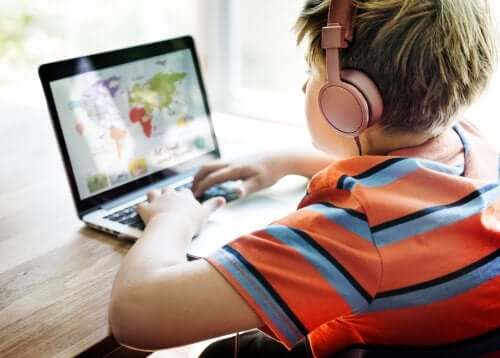The Gamification Strategy in Elementary School

Nowadays, it’s important to make school meaningful, but it should also be fun and motivating. The gamification strategy uses games so students can learn in a creative and fun way.
Elementary education
Elementary school is an educational stage that has six courses, usually between ages 6 and 12. It’s divided into levels, and has different subjects to teach lots of topics.
The goal of elementary school is to teach kids how to read, write, and express themselves. They also learn subjects such as math, history and art, as well as work on their social skills, creativity and imagination.
In this way, elementary education helps develop kids’ personalities. In addition, it prepares them for middle school and high school.

In elementary school, the gamification strategy is a very good tool to keep kids engaged so they’re interested in their education.
What is the gamification strategy?
Gamification refers to a learning technique. It uses games to facilitate learning. In fact, you can do this both offline and online, thanks to new technology in the classroom today.
It uses games for educational purposes, so there’s some kind of reward for reaching objectives. On the other hand, they motivate kids to keep reaching for new goals.
The objective of the gamification strategy is that kids can learn new things in different situations. In addition, they develop emotional and social intelligence, and improve skills.
Sometimes, schools use gamified classes, where the games are an integral part of class. In fact, lots of schools use games to teach different lessons.
Examples of the gamification strategy
As we mentioned earlier, games have always been used in the classroom. However, there are even more games available because of technology.
There are lots of platforms you can use in elementary school where kids can learn by playing. In fact, they can learn about school topics, as well as learning how to use new technology.
Here are some powerful digital tools to use the gamification strategy in the classroom:
Duolingo
It lets you learn new languages by playing, practicing grammar and translation. It starts with short and simple lessons. You also get points for answering correctly, and you can move up in levels.
ClassCraft
This is a site that uses the imagination to enhance teamwork, leadership, empathy, student motivation and classroom management. Additionally, you can create characters, like warriors and magicians, who do missions, earn points and gold.

More examples of the gamification strategy
ChemCaper
Through this platform, you learn fundamental chemistry concepts in a fun way. For example, you can learn elements, groups, types of chemical bonds, and more. It’s mainly for kids ages 10 to 14.
The World Peace Game
In this political simulation, kids have to face social, economic and environmental crises. It’s a great way for the whole class to interact and learn about how countries interact.
ClassDojo
This is a very popular classroom management platform for elementary school. In it, kids get points for their behaviors. You can create profiles, use avatars, earn points and even medals.
ST Math
ST Math is a great example of the gamification strategy to learn math. A penguin motivates the students when they face challenges. It’s great both for kids with learning difficulties, and kids with great skills.
Nowadays, it’s important to make school meaningful, but it should also be fun and motivating. The gamification strategy uses games so students can learn in a creative and fun way.
Elementary education
Elementary school is an educational stage that has six courses, usually between ages 6 and 12. It’s divided into levels, and has different subjects to teach lots of topics.
The goal of elementary school is to teach kids how to read, write, and express themselves. They also learn subjects such as math, history and art, as well as work on their social skills, creativity and imagination.
In this way, elementary education helps develop kids’ personalities. In addition, it prepares them for middle school and high school.

In elementary school, the gamification strategy is a very good tool to keep kids engaged so they’re interested in their education.
What is the gamification strategy?
Gamification refers to a learning technique. It uses games to facilitate learning. In fact, you can do this both offline and online, thanks to new technology in the classroom today.
It uses games for educational purposes, so there’s some kind of reward for reaching objectives. On the other hand, they motivate kids to keep reaching for new goals.
The objective of the gamification strategy is that kids can learn new things in different situations. In addition, they develop emotional and social intelligence, and improve skills.
Sometimes, schools use gamified classes, where the games are an integral part of class. In fact, lots of schools use games to teach different lessons.
Examples of the gamification strategy
As we mentioned earlier, games have always been used in the classroom. However, there are even more games available because of technology.
There are lots of platforms you can use in elementary school where kids can learn by playing. In fact, they can learn about school topics, as well as learning how to use new technology.
Here are some powerful digital tools to use the gamification strategy in the classroom:
Duolingo
It lets you learn new languages by playing, practicing grammar and translation. It starts with short and simple lessons. You also get points for answering correctly, and you can move up in levels.
ClassCraft
This is a site that uses the imagination to enhance teamwork, leadership, empathy, student motivation and classroom management. Additionally, you can create characters, like warriors and magicians, who do missions, earn points and gold.

More examples of the gamification strategy
ChemCaper
Through this platform, you learn fundamental chemistry concepts in a fun way. For example, you can learn elements, groups, types of chemical bonds, and more. It’s mainly for kids ages 10 to 14.
The World Peace Game
In this political simulation, kids have to face social, economic and environmental crises. It’s a great way for the whole class to interact and learn about how countries interact.
ClassDojo
This is a very popular classroom management platform for elementary school. In it, kids get points for their behaviors. You can create profiles, use avatars, earn points and even medals.
ST Math
ST Math is a great example of the gamification strategy to learn math. A penguin motivates the students when they face challenges. It’s great both for kids with learning difficulties, and kids with great skills.
All cited sources were thoroughly reviewed by our team to ensure their quality, reliability, currency, and validity. The bibliography of this article was considered reliable and of academic or scientific accuracy.
- Contreras Espinosa, R. S. (2016). Juegos digitales y gamificación aplicados en el ámbito de la educación. RIED. Revista Iberoamericana de Educación a Distancia, 19(2). Recuperado de https://www.redalyc.org/html/3314/331445859002/
This text is provided for informational purposes only and does not replace consultation with a professional. If in doubt, consult your specialist.








